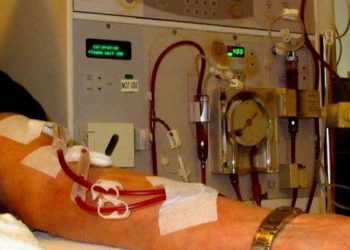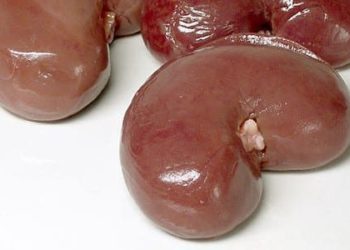Restrictive intraoperative vascular filling is a strong risk factor for postoperative acute kidney injury
1. Of the many identified associations between perioperative variables and AKI following radical cystectomy, restrictive intraoperative vascular filling < 5ml/kg/h was strongly and independently associated with AKI.
2. There is a significant association between postoperative AKI and the incidence or worsening of CKD in patients following radical cystectomy
Evidence Rating Level: 2 (Good)
Study Rundown: Radical cystectomy (RC) for bladder cancer is associated with significant morbidity, even with Enhanced Recovery After Surgery (ERAS) protocols. Fluid management, a key ERAS component, can aim for fluid restriction to enhance outcomes. However, concerns about hypovolemia and acute kidney injury (AKI) remain. AKI, affecting up to 40% of RC patients, can lead to chronic kidney disease (CKD) or worsening of existing CKD. This study analyzed perioperative variables and their associations with AKI within 30 days post-RC, as well as the development or worsening of CKD over two years. 30 days following RC, 58.2% of patients had developed AKI, with a mean onset of 4.5 days post-surgery. Most AKI cases (73.2%) were stage 1, and 93% had recovered by day 30. Univariate analysis identified several risk factors for AKI, including restrictive intraoperative fluid management (<5 ml/kg/h), sex, BMI, preoperative stenting, robotic surgery, sepsis, and various clinical scores. Multivariate analysis confirmed that restrictive vascular filling, postoperative sepsis, female sex, high SOFA score on day 1, and early serum creatinine changes were independent predictors of AKI. The study found a significant association between postoperative AKI and the development or worsening of CKD over two years. No link was observed between AKI and two-year mortality. Despite limitations, such as potential selection bias, the findings highlight the importance of cautious fluid management in preventing AKI and long-term renal complications in RC patients.
Click to read the study in PLoSOne
Relevant Reading: ERAS Protocols
In-Depth [retrospective observational study]: A major component of the treatment of bladder cancer involves surgical radical cystectomy (RC). However, this procedure has a high rate of morbidity even after the introduction of enhanced recovery after surgery (ERAS) protocols. One branch of ERAS is fluid management which aims to keep the patient at euvolemic status. In colorectal and abdominal gynecological oncological surgery, ERAS protocols show reduced incidence of major and gastrointestinal complications as do reduced hydration strategies. However, the concern for subsequent hypovolemia and acute kidney injury (AKI) remains persistent. The major complications of RC include gastrointestinal, urinary, and renal complications with AKI occurring in up to 40% of patients. Post-operative AKI is associated with severe morbidity and mortality. Patients who successfully recover from AKI are more likely to develop incident chronic kidney disease (CKD). In RC patients who recover from AKII, 25-50% go on to develop CKD. The objective of this study was to identify associations between perioperative variables, including components of the ERAS protocols, and the occurrence of postoperative AKI within 30 days of RC. Additionally, the study looked for any associations between AKI cases and the incidence or worsening of CKD in the following 2 years. From February 2015 to September 2019, 112 patients were included in the study. The main surgical approaches used were robotic-assisted surgery and laparotomy with 17 patients undergoing a mixed procedure. The average surgery duration was 421 minutes (346-501), norepinephrine was used in 11% of the patients, total vascular filling was 5.1 ml/kg/h (3.8–7.5), blood loss 400 ml (250–600) and 14 patients received (11.4%) an intraoperative blood transfusion. At day 30, 80.3% of patients had postoperative complications. 71 patients (58.2%) developed an AKI by day 30 with a mean onset time of 4.5 days. 24 (20%) of the included patients developed an AKI after day 1. Using the KDIGO criteria, 52 were classified in stage 1 (73.2%), 10 in stage 2 (14.1), and 9 in stage 3 (12.7%). 57 of the 71 patients who developed an AKI were fully recovered by the 10th day and 66 (93%) had recovered by the 30th day. No significant difference between the compliance to ERAS protocols was seen between the AKI and non-AKI groups (p = 0.432). Univariate analysis showed the main factors associated with postoperative AKI were sex (p = 0.002), BMI (p = 0.038), preoperative double J stent (p = 0.001), robotic-assisted surgery (p = 0.016), restrictive intraoperative vascular filling < 5ml/kg (p = 0.035), SAPSII score (p = 0.001), SOFA score on day 1 (p = 0.001), duration of surgery (0.002), duration of laparoscopy (p = 0.017, postoperative sepsis (p = 0.011), serum potassium on day 1 (0.002), delta serum creatinine D1 (p<0.001). The type of chemotherapy and TNM staging were not associated with postoperative AKI. Multivariate analysis showed the factors independently associated with AKI were intraoperative restrictive vascular filling < 5ml/kg/h (OR = 4.39, 95%CI (1.05–18.39), p = 0.043), postoperative sepsis (OR = 4.61, 95%CI (1.05–20.28), p = 0.043), female sex (OR = 0.11, 95%CI (0.02–0.73), p = 0.022), SOFA score (Sequential Organ Failure Assessment) at day 1 (OR = 2.19, 95%CI (1.15–4.19), p = 0.018) and delta serum creatinine D1 (OR = 1.06, 95%CI (1.02–1.11), p = 0.006). No association between postoperative AKI and 2-year mortality was seen (p = 0.959). 36 patients had CKD occurrence or worsening showing a significant association with postoperative AKI (p = 0.019). Therefore, after RC in cancer bladder patients, AKI occurred frequently and was strongly associated with developing or worsening of CKD within the 2 years following surgery. A restrictive intraoperative vascular filling < 5ml/kg/h was the most strongly and independently associated factor associated with postoperative AKI in this context. The retrospective nature of this study makes the results susceptible to selection bias however all perioperative factors were collected prospectively.
Image: PD
©2025 2 Minute Medicine, Inc. All rights reserved. No works may be reproduced without expressed written consent from 2 Minute Medicine, Inc. Inquire about licensing here. No article should be construed as medical advice and is not intended as such by the authors or by 2 Minute Medicine, Inc.









